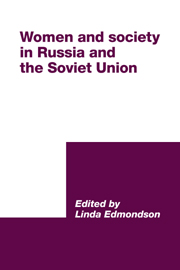Book contents
- Frontmatter
- Contents
- Notes on contributors
- Preface
- Introduction
- 1 ‘Better halves’? Representations of women in Russian urban popular entertainments, 1870-1910
- 2 The Silver Age: highpoint for women?
- 3 Women pharmacists in Russia before World War I: women's emancipation, feminism, professionalization, nationalism and class conflict
- 4 Women's rights, civil rights and the debate over citizenship in the 1905 Revolution
- 5 Laying the foundations of democracy in Russia: E. D. Kuskova's contribution, February–October 1917
- 6 Mariia L. Bochkareva and the Russian amazons of 1917
- 7 Russian women writers: an overview. Post-revolutionary dispersion and adjustment
- 8 Victim or villain? Prostitution in post-revolutionary Russia
- 9 Young women and perestroika
- 10 Glasnost and the woman question
- Index
Preface
Published online by Cambridge University Press: 22 October 2009
- Frontmatter
- Contents
- Notes on contributors
- Preface
- Introduction
- 1 ‘Better halves’? Representations of women in Russian urban popular entertainments, 1870-1910
- 2 The Silver Age: highpoint for women?
- 3 Women pharmacists in Russia before World War I: women's emancipation, feminism, professionalization, nationalism and class conflict
- 4 Women's rights, civil rights and the debate over citizenship in the 1905 Revolution
- 5 Laying the foundations of democracy in Russia: E. D. Kuskova's contribution, February–October 1917
- 6 Mariia L. Bochkareva and the Russian amazons of 1917
- 7 Russian women writers: an overview. Post-revolutionary dispersion and adjustment
- 8 Victim or villain? Prostitution in post-revolutionary Russia
- 9 Young women and perestroika
- 10 Glasnost and the woman question
- Index
Summary
All the contributions to this volume were written in 1990 and revised before the disappearance of the Soviet Union. One small consequence of the final collapse of the Soviet system has been to render obsolete many place names and names of institutions that only a few months ago were still current usage. We have made some minor modifications to the texts of a number of the essays, but have decided to leave those by Sue Bridger and Mary Buckley substantially as they were. It would have been possible, if cumbersome, to have reset every ‘is’ as ‘was’ but to do so would give the impression that the conditions and debates recorded in both these chapters have disappeared along with the USSR. The problems that both these authors discuss are as pertinent to the Commonwealth of Independent States in 1992 as they were to the Soviet Union in 1990. As no one can be sure what the ‘former Soviet Union’ will look like a year, or five years, from now, it seems better to let these chapters stand, in effect, as eye-witness reports on the ‘woman question’ in the era of perestroika, and to leave it to future reporters to discover what effects the far-reaching political, economic and social changes of the coming years will have on the daily lives and aspirations of women in those lands that once comprised the Soviet Union.
- Type
- Chapter
- Information
- Women and Society in Russia and the Soviet Union , pp. ix - xPublisher: Cambridge University PressPrint publication year: 1992

